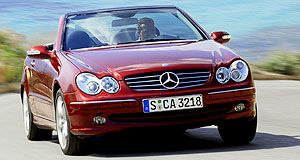CLK under $100K
BY BYRON MATHIOUDAKIS | 7th Mar 2005

The CLK 200 Kompressor inherits the 1796cc twin-cam 16-valve four-cylinder supercharged engine found in a host of other C-Class-derived Mercedes models, including the CLK coupe that the Cabriolet is based on.
The sole transmission on offer is a five-speed automatic with a Tiptronic-style manual shift control.
With the aid of a newly revised supercharger combined with variable-adjustment camshafts (which both boost torque flexibility), the 1.8 motor manages 120kW of power at 5500rpm and 240Nm of torque between 3000 and 4000rpm.
This is enough for the rear-wheel drive drop-top to hit the 0-100km/h mark in 10.5 seconds on its way to a 225km/h top speed – a 7km/h improvement on the last-generation 120kW/230Nm 2.0-litre CLK 200K.
It also allows for a 60 to 120km/h time in fifth gear of 17.4 seconds.
Along with lower emissions, fuel consumption has also improved, down from 9.9 to 8.9l/100km according to the European NEDC combined consumption cycle.
Mercedes claims that the 1.8 “Twinpulse” unit has the refinement and acoustics of a six-cylinder engine, thanks to a Lanchester balancer consisting of tow forged shafts supported in multiple bearings that counter-rotate at twice the crankshaft speed to help eliminate vibrations.
The latest 200 Kompressor Cabriolet brings the total A209-series CLK range to five – 240, 320, 500 and 55 AMG.
All 2005 model-year CLKs now employ something Mercedes calls “Direct Control” technology, which features modified bearing and more direct steering for better handling without ruining the ride.
New-to-CLK options include steering wheel gearshift buttons, upgraded audio units with improved satellite navigation, and bi-Xenon headlights with a cornering-light function.
Mercedes says that the base CLK 200K’s standard features list mirrors that of the $106,600 CLK 240 V6.
Dual front and side airbags, anti-lock brakes, electronic stability control with brake assist, an electrically operated roof, climate control air-conditioning, leather upholstery, cruise control, a six-stacker CD player, a trip computer and alloy wheels are amongst the standard items.
CLK sales have risen 94 per cent since 2000, despite the return of the Audi (A4) Cabriolet in 2002 and the introduction of an all-new Saab 9-3 drop-top in 2003, along with a facelifted BMW E46 3 Series Convertible.
In 2004 it led the luxury ragtop segment with 810 cars versus the second-placed 9-3’s 724 sales, 643 3 Series and 206 A4s sold.
But Saab’s February introduction of a $66,900 base 9-3 Linear version may see the Swedes swipe back the segment crown from Mercedes.
Aimed at the upper premium drop-top market (such as the Peugeot 307 CC) this 9-3 is $6000 cheaper and makes do with a slightly less powerful 2.0-litre turbo engine (down 19kW to 110kW), but keeps virtually everything else.
The first CLK Cabriolet arrived locally in October 1998, while the last CLK 200 K sold locally was the 2000-2004 series.
It overlapped with the new-generation CLK Cabriolets launched in mid-’03, a year after its coupe counterpart’s debut.
The last CLK derivative released here before the 200 K was in July last year, when the 240 docked.